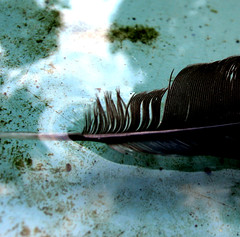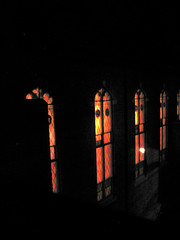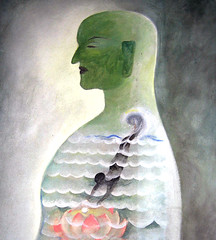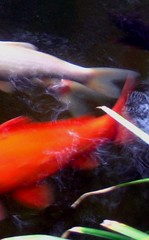I am having a quiet day at work. It seems no one else bothered to show up or even call.
My experiment is in the centrifuge and I have a moment free to polish up what I’d planned for my next entry here.
Some notes are in a spiral notebook which I’ve pulled out of my bag to reference.
It’s just this notebook I picked up before I went to the Garrison Retreat. It seemed to have some empty pages. I didn’t know, or care, what else was in there.
So, I was flipping through the pages just now when my eyes happened upon what follows.
I’m interjecting it here since it comes so closely on the heels of Eddie's passing.
Also, I spent last weekend with my Taoist teacher, Wong Loh Sin See, and these words fit with that experience also.
The Teacher and I hadn’t seen or spoken to each other for six months, yet he opened the workshop with these words, “Patty, life and death, what is the difference?”
The question took me by surprise, but after some reflection, I replied, “A form is either here or gone.”
He asked me to say more, and our whole exchange seemed an exercise to re-enforcing a moment I’d experienced with Eddie.
As I'd sat with him, I noticed that the Silence within me was also within Eddie. And, I knew that Silence would continue even after Eddie’s form was gone.
Apparently, The Teacher wanted me to see this once again.
And apparently, The Teacher also wanted to show me that there is a formless Consciousness “out there” that personally listens in upon my thoughts and musings. (He does that every workshop.)
So, this passage in the notebook has caught my eye.
I don’t remember ever writing any of this down.
It begins with a quote. My guess is that this is Eckhart Tolle speaking:
Death means a form is dissolving.
It dissolves and then what’s left is formless Consciousness…
When you observe how your breath moves out,
the end of that breath is also a little death,
and there is a moment of stillness…
Any ending is helpful in that way.
Because any ending is the end of a form
and it is always some kind of death.
When you accept it fully, it is an opening
into the formless…
And you want to hold onto the form,
(a recipe for unhappiness)
not realizing that the very reason why this [moment] is meaningful
is that it takes you beyond form.
So the more you welcome all the endings in your life,
“Good-bye! Ah, a form is going,”
the more formlessness there is in life.
The egoic entity works the opposite way.
It hates this. It thinks, “Oh, no! I want to keep this.”
But, it’s going, going, going. Everything.
If you are old enough and can see the death of this physical form approaching
that can be very beautiful too…
Let it push you into being present.
Just that.
I can remember that the last few years of my father’s life
he grew quieter and quieter at family functions.
I see him seated there at the head of our table.
Watching, smiling, sometimes somewhere else, and then back to offer a brief comment,
he was no longer the central presence, no longer “The Rock,” as we had called him.
I got a call from Peggy last night. She was in New York having just spent a one-day Thanksgiving upstate visiting her mother.
I could feel the tears brimming in her eyes as she described,
“Ninety-one. Her health is good. They do all these things… but, she’s turned inside.”
I said, “The actress no longer speaks to the back of the room.”
“No.”
Nor does she pay her children all that much attention.
But, she has discovered Nature.
Now, she’ll stop to look closely at a bud and comment to her daughter, “I never knew!”
But, we all know, somewhere deep inside.
We know about the formless and the form, and the play between the two.
It’s just that
Being awake requires such a light touch.
Being awake requires letting the treasured dissolve away.







